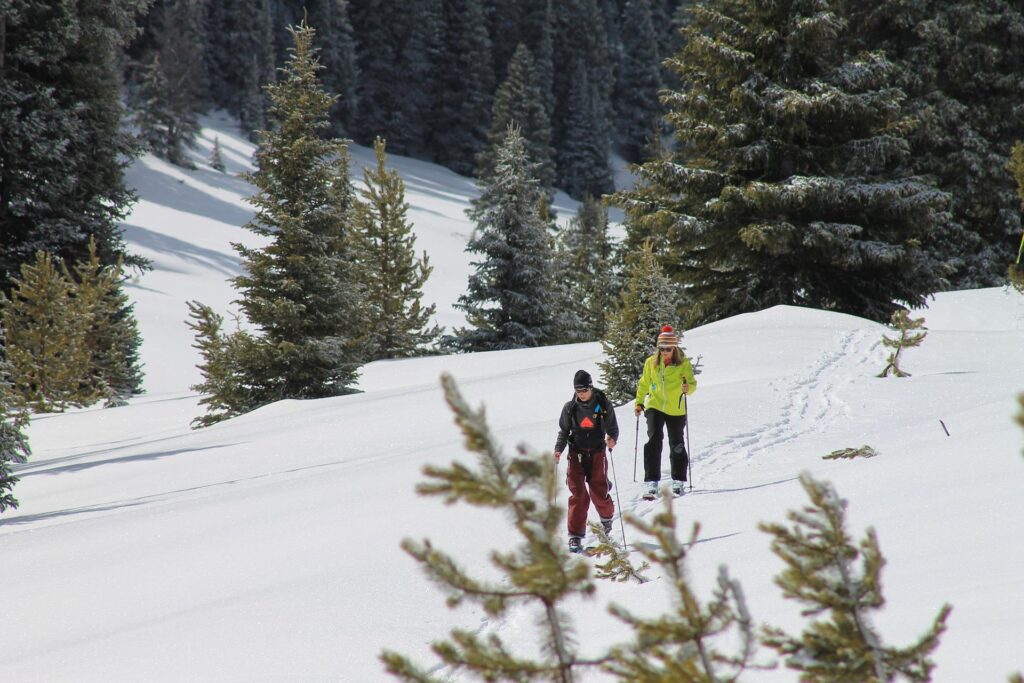Piste is a marked and groomed skiing trail and if you are skiing on one of these, on-piste skiing it is. But many skiers are drawn to ungroomed and unmarked trails as they offer more natural landscapes, freedom, and greater challenges. This is referred to as off-piste skiing.
What Exactly is Off-Piste Skiing?
When you hit the slopes, you might hear people use the term “off-piste.” But what does off-piste skiing mean? Essentially, it means skiing outside of the groomed trails.
This can include powder skiing, backcountry skiing, and even hiking up to ski down a mountain that hasn’t been groomed. While off-piste skiing can be more adventurous and thrilling, it also comes with some risks.
The snow can be more challenging to ski on, and there might be hidden obstacles beneath the surface. As a result, it’s important to take precautions when venturing off the beaten path.
Make sure you are well-equipped for the conditions, know your limits, and always ski with a partner. With some preparation and caution, you can safely enjoy the thrills of off-piste skiing.
Challenges of Off-Piste Skiing
Obviously, with greater freedom comes greater responsibility. Skiers looking forward to off-piste trails need to be aware of key challenges and risks and try to mitigate them. One of the key risks when skiing off-piste is running into avalanches.
Going off the trail usually means that skiers have to assess risks on their own and the support that might be available to on-piste skiers is either unavailable or can have longer response times. An avalanche, where the snow descends down a slope due to warming temperature, can cause accidents and injuries that can even be fatal.
Therefore, it is important for skiers looking to undertake off-trail skiing to learn to assess the risk of avalanches on the path they intend to take. Skiers often also need to assess the snowpack stability of the area surrounding their actual ski trail.
It is also important to note that while risk assessment is a good way to start your backcountry skiing, it does not guarantee safety, as weather conditions can be, sometimes unpredictable and change dramatically.
If you are looking to explore a new terrain which is ungroomed and unpatrolled, you also run the risk of running into obstacles that you are not aware of. With on-piste skiing you do not have to worry about coming across a cliff or another hurdle of some sort halfway through your trek but unexplored tracks can present new challenges that skiers need to be equipped, both mentally and with appropriate gear, to deal with them.
Off-piste skiing can also take you into remoter areas where rescue teams might take longer to respond to calls for assistance in case of injuries or other complications. This means that before embarking upon an unmarked skiing course, you need to take the risks associated with it into account.
Experience Matters
Statistically, however, more accidents tend to take place during on-piste rather than off-piste skiing. And although a major reason for this might be the higher experience level of skiers undertaking off-piste skiing, the risks associated with it does not mean that you should not consider it at all. In fact, skiing off-piste can definitely offer much more exhilarating experiences than skiing on marked piste tracks.
Seasoned skiers are often drawn to the phenomenon of creating their own ski marks and venturing towards unchartered territories. And the risks associated with such a pursuit do not and cannot entirely impede the fascination and charm that off-piste skiing holds.
But if you are just kicking off your skiing journey, it is important to first train and apprise yourself of the governing factors at play before you embark on a free skiing blaze. It is also, perhaps, advisable to get a trained instructor or guide onboard, at least until you are comfortable with navigating the mountains on your own.

